You may have finally arrived at the point where your patio is ready for a next level look and you’re just a little hesitant as to how you’ll go about it. Today, we’ll look into some tips on how to arrange your patio furniture so that you won’t come to regret your efforts later. In reference to Starsong Outdoor Furniture’s – 10 Tips on How to Arrange Patio Furniture, we’ll be considering some key factors that will play an integral role in the success of your arrangement.
Before we look into the tips, you may want to envision the end result of your patio. Perhaps, you have a vague idea of its intended use, having guests or lounging by yourself. Maybe you already have a demanding environment that will require your new patio to meet certain needs, like the constant flow of traffic of pets and children. For me, I imagine a space that could potentially evolve throughout the years to include pets and a family, but for now, a small space will do. I simply need an area to study or enjoy a moment of reflection. Your patio’s purpose will help you determine your arrangement, thus giving this process a starting point.
A good patio arrangement enhances the mood of your outdoor space. Accessibility means that you’ll find the experience convenient and aesthetically pleasing. How the flow of both people through the space and your eyes across it can sometimes make or break your decision to leave the living room and head outside. There may be features on your properly that you’d like to showcase, and with a proper patio arrangement, you can achieve just that.
Whatever your dream patio is at this point, you’ll want to aim for it realistically as well as consider changes in the future. By narrowing down the possibilities rationally and developing a plan, you’re more likely to enjoy the end result. That being said, if you find a ceramic duck sculpture and you can’t stop thinking of how much you’d love it to go on your patio, by all means- get the duck, but on the big decisions- having foresight is key.

Understanding your space
Before you begin to physically arrange elements of your patio, you’ll want to take a tour of its space. Note how things like railings, doors, windows, foliage, and sunlight affect the space. Are there ideal places to gather? Are there areas that you want to avoid? Using your patio as a blank canvas for your imagination to shift elements upon can greatly reduce the need for you having to do it later physically. (But if that’s your thing, rearranging tangible objects, don’t feel like you need to hold back.)
You’ll want to measure your area so that you can better understand what space you have to work with by numbers. At this point, you may even want to sketch your area on paper or use some other method to map it out for you. This way, you can organize different elements on paper before committing to them.
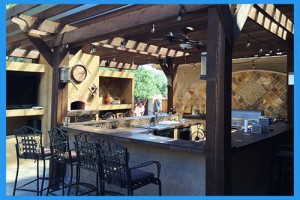
Find ways to compliment your lifestyle
When selecting elements to place on your patio, you’ll need to consider your vision again. If your purpose is to host outdoor dinners, you may want to include a table with seating as well as room to present food items.
Perhaps, you’re looking for your patio to be the place where everyone can unwind. You’ll want to include comfortable deep seating and plenty of space to lounge.
Your patio may even include a firepit or be used as a compliment to a pool area. The point is to set it up so that it meets your needs. Many patio arrangements look nice, but if they don’t gel with your lifestyle, you may not want to emulate them. Acquire furniture and elements that will enhance your personal lifestyle.
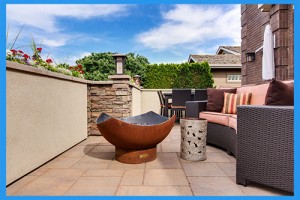
Focal point selection
Once you’ve selected pieces that will work for you, you’re going to want to consider the actual layout of those pieces on your patio. This is where your focal point becomes important. The focal point is what your guests will gaze at most when they lounge on your patio furniture. If you have a firepit, that would likely be an obvious choice due to the lure of the bright, dancing flame. You may even have a view of a lake or cityscape that you want your guests to get lost in during their visit. You can choose what each piece of furniture faces towards, sit down, and pretend to go through a guest’s experience to see what they’ll see. If you’re not sure if you like what you’re experiencing, you may opt to adjust your arrangement or even the focal point.
If you have a firepit, arrange chairs around it so that each guest gets a great view of the focal point. You may even want to add a few tables between those chairs so that they have places for drinks or personal items, etc.
For a focal point of a landscape, you’ll want to arrange your furniture so that most of it, if not all, is facing in the direction of the landscape. You may need to get a little crafty with angles because you might end up having just a line of chairs all facing the same direction. In this situation, the lack of face to face conversation can prove to be difficult and you may find that you and your friends are all staring at a beautiful mountain but hearing each other’s voices narrate the entire script of “The Office.” Yes, focal points are important, but your real goal is to make the space enjoyable. Does the focal point make the space or does the experience with your guests? Being able to look at each other can be more of a priority than your scenic backyard. Don’t aim to get too stiff.
Creating flow
Just like when you’re indoors, you’re going to want to consider how you move around the furniture. Tight spaces can be awkward and uncomfortable, so look for ways to keep areas open and free. You’ll be interacting with the elements of your patio more than just comfortably lounging on them. For longer items, place them against a wall to compact the amount of space they take up. From there, you can arrange smaller items around them with various paths to enter and exit.
You should keep in mind your focal points and how the arrangement will affect your guests’ experience when viewing them. You don’t want to keep all the elements tightly placed together. By doing that, you can create hazardous situations as well as make your guests struggle to get around.
If you plan to continue using your patio arrangement or adding elements that are potentially more dangerous, consider how different periods of the day may require different considerations. During the night, would your patio arrangement still be safe to use if a firepit is now creating a hazard? Will you have to make some changes to accommodate the different times of day in regard to safety and comfort?
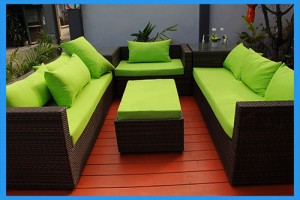
Achieving balance
Imagine your space from above. When you look at all of your elements together, do they seem scattered or balanced? Balance doesn’t always mean symmetrical; it can be an equal dispersement of elements so as to not create a feeling of disorientation.
Strategizing where each piece will be in relation to the other pieces can change the entire feeling of the outdoor living space. Some ways to consider the balance of your patio might include the seating area, where you may want to distribute equal space to each item while having them surround a focal point. For long outdoor sofas, you can achieve a look of balance by adding a pillow on either end. For larger patios with different areas to gather, you may want to give each one of those areas similar amounts of surrounding room between them. Be sure to leave space for movement among the different areas and elements of your patio.
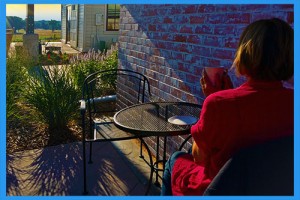
Utilizing small spaces
Small patios may seem impossible to make use of but they just require a certain set of eyes. Adding less elements in a more tactical way can create an enjoyable space. You may want to invest in a dining set that is smaller, such as a two to three chair bistro set, as well as identify your hosting area with a simple, yet defining element like a throw rug. This tip is ideal for someone like me. I don’t currently own a patio, but I would definitely enjoy just a tiny getaway like this one.
Accenting: After laying out the larger elements, you may still feel the need for more. Accenting can go a long way to add personal touches to an outdoor living space. At this point, you may not need to resort to your original vision. Adapting by adding highlights of colors and details, such as lighting and foliage, can really bring a whole look together. Certain accents can take up more space than you initially thought, so keep your priorities in mind and be willing to make some decisions on what should stay and what should go. Consider storage space as well as supplies that you’ll need to maintain your patio. Lighting, candles, and pillows can create a warm and cozy atmosphere, while finding unique antiques or creating art that would complement your layout could be a game changer in the entire mood of your patio.
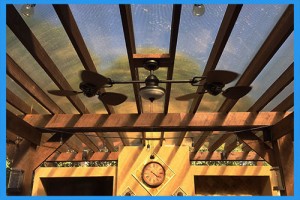
Integrate shade
There is an opportunity to utilize the benefits of shade as well as create them. You may want to intentionally place certain areas of seating in the shade so that they can be enjoyed on a particularly hot day. Natural shading is something that you can play off of when you develop your layout, including the use of trees and foliage. You can also find ways to create shade by using things like garden structures. Pergolas, umbrellas, awnings, even a makeshift sheet hung by clothesline might help diffuse the sunlight and make your patio layout more enjoyable on bright days. Create balance in your layout by means of exposure to natural the elements, if you can, so the use of your patio will not become obsolete in inclement weather.
Functionality around the pool area
If your patio layout is meant to be a part of the pool area, you’ll want to choose modular furniture. That is, furniture that can easily shift from one position to another. Pool areas often undergo different uses throughout the day and may demand furniture that can quickly adjust. You’ll likely want to arrange your seating around the corners of the pool or select a side that you’ll designate all seating and dining to. Activities in around the pool work best with large amounts of open space, so be sure to keep a fair amount of room for both comfort and safety throughout all times of the day.
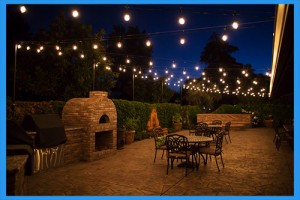
Take advantage of outdoor lighting
Outdoor lighting is almost a necessity. It serves as a safety measure as well as a tool to create atmosphere. In regard to safety, you should consider areas that truly would benefit from outdoor lighting. Some good examples are high traffic areas, dimly lit walkways, large dining areas, doorways, and places where children will spend time. If you’re looking to create ambiance with your lighting, using candles and firepits can provide an amber glow that may be further embellished with fairy lights or free-standing lamps. Safety should be your top priority when it comes to fire and electricity, so be sure to leave enough room and follow the proper procedures when dealing with potentially dangerous elements.
Utilizing these tips to arrange your patio furniture can greatly reduce the stress of the process. By considering the benefits of the principals of design, your outdoor living space can be more than functional and comfortable; it can be visually appealing and stylish. The goal is to balance your space, not to feel eager to fill it up entirely or leave it barren. By portioning your space with a few practical and favorable pieces, you’ll look forward to making use of your patio.
Begin your patio layout at Fifthroom.com and get inspired today!

0